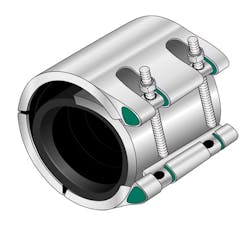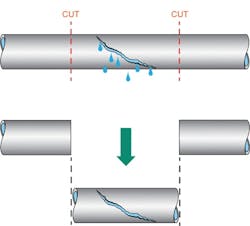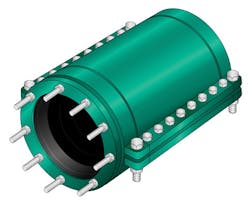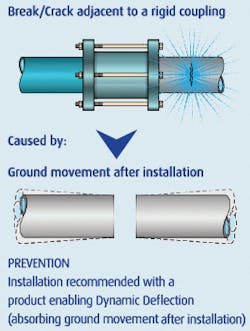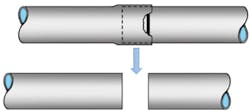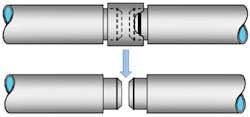Clamp Alternatives for Pipe Repair
Yan Brunshteyn is product manager for Krausz. Avi Chiproot is vice president of engineering for Krausz. Brunshteyn and Chiproot can be reached at [email protected].
undefinedFlat gasket repair clamps are used to repair pipes in many scenarios, including those where clamps have no business being used. Proper applications include repairing holes, cracks and pitting in pipes. As described in last month’s article, Flat Gasket Repair Clamps, repair clamps often are used to improperly fix shear breaks (“the Bad”). Even worse, they are installed to insufficiently repair separated, misaligned and deflected pipe, as well as damaged or broken bell or sleeve joints (“the Ugly”). Using clamps in these kinds of scenarios lead to future breaks, water loss, and wasted time and money for municipalities and water utilities.
This article will offer proper solutions for these kinds of repairs and provide a guide for sound techniques for installers, engineers, maintenance managers and anyone else involved in these repairs.
How to Repair Broken Pipe
There are three types of products that provide permanent solutions for separated, misaligned and deflected pipe, and damaged or broken bell or sleeve joints:
1. Openable or wraparound split-sleeve couplings.
According to AWWA standard C227, a split-sleeve coupling must have a split cylinder but that does not necessarily make it openable. Openable or wraparound couplings can be wrapped around pipe without cutting out or removing sections of pipe. For bell or sleeve joint repair, the bell or sleeve must first be cut out, and then the openable split-sleeve coupling is used to perform the repair. The value of this kind of coupling is beginning to gain traction throughout the U.S. water industry and has gained wide acceptance in many parts of Europe.
2. Section replacement method with two regular couplings.
This pipe repair technique requires cutting out the damaged section of pipe, slipping couplings on both ends of a replacement pipe, and then closing the two couplings to complete the pipe repair.
3. Encapsulation repair sleeve.
This product type is specifically designed to repair a bell or sleeve joint break without using the “section replacement method.” The encapsulation repair sleeve enables the utility to perform a bell or sleeve joint repair without completely shutting off the water. Keep in mind that performing a repair with full water pressure can be dangerous, and reducing it will better ensure worker safety.
With encapsulation repair sleeves, utilities can avoid having to distribute much-hated “boil water” notifications, and can repair the pipeline without chlorination. This kind of repair is faster than the section replacement method, and allows business to continue as usual. On the downside, these are dedicated-size products that are very heavy and expensive.
Keep in mind that the types of breaks represented are primarily due to ground movement, and the proper solution must be flexible to accommodate these forces. Rigid coupling solutions will lead to further breaks, as illustrated by the graphic above.
Let us now review the plusses and minuses of each of these three solutions for repairing separated, misaligned and deflected pipe, and damaged or broken bell or sleeve joints.
Proper Repair for Shear Breaks
Caused by ground movement or other bending forces, shear breaks result in pipes that are split in two. In such cases, you can use an openable split-sleeve coupling or the section replacement method with two couplings that offer dynamic deflection.
Section replacements offer a permanent repair compared to using a clamp, while the dynamic deflection technology helps to absorb ground movement to prevent future breaks. With two of these kinds of couplings, there is added flexibility on the section of pipe where it is needed most.
The disadvantage of this method is that it is a longer and more expensive repair process. It requires turning off the pipeline for a significant period of time and distributing boil water notices. For a fast and cost-effective solution, an openable split-sleeve coupling with dynamic deflection is a good choice.
Repairing Separated, Misaligned or Deflected Pipe
All of these breaks happen after occurrences of ground movement or other forces acting on the pipe. As mentioned in the previous article, such breaks cannot be properly solved with a flat-gasket repair clamp. It is simply not built to withstand such forces.
To address these kinds of breaks, we must first and foremost recognize that ground movement is the primary cause, and any solution must address this fact. The coupling cannot be rigid and must have dynamic deflection as defined by Section 3 of AWWA standard C227. Dynamic deflection allows pipe to deflect angularly post-installation and during the service of the pipeline. By contrast, static deflection allows only for installation on already deflected pipes, with the coupling becoming rigid once installed. As with repair solutions for shear breaks, the two repair options are the section replacement method or an openable split-sleeve coupling. As mentioned above, the latter solution is optimal in terms of installation time, cost and ease of use.
Bell & Sleeve Joint Break Repair
Bell and sleeve joint breaks can be especially difficult to repair, requiring painstaking attention to detail, especially if the pipe is made from asbestos cement. In these cases, hazmat precautions need to be taken into consideration. Even if you are not dealing with asbestos cement, repairing leaking bells comes with other complex and costly issues, such as pipeline shutdowns, boil water notifications, loss of service notifications, business and community complaints, difficult repair conditions, and pipeline chlorination.
For these kinds of breaks, a flat gasket repair clamp is not sufficient. All of the three above solutions can be employed—however, each of them has their own advantages and disadvantages. The section replacement method works but does not avoid the extra time and cost mentioned before. The openable split-sleeve coupling requires shutting down the pipeline, but is easier to install and less costly than the section replacement method.
Encapsulation repair products allow utilities to avoid the difficulties noted above, but are more expensive and difficult to install. They also are designed for dedicated sizes, which requires utilities to stock multiple sizes in preparation to repair all possible pipe outer diameters. If the break is for an unexpected pipe size, however, you are still left with the first two repair options.
Summary
Many see repair clamps as temporary and inexpensive solutions for serious pipe breaks, while others think that continual replacement of repair clamps is just a regular occurrence. They see no issue using repair clamps, claiming, “This is how we’ve done it for 20 years and it’s been fine.” But there is a better way, and installers have several repair options that provide long-term, permanent solutions to reduce water loss and costs to municipalities.
All the solutions described address ground movement, the central cause of pipe breaks. By using only rigid couplings or, worse, clamps, installers will find that repairs will need to be made repeatedly.
The section replacement method with two couplings, openable or wraparound split-sleeve couplings and bell or sleeve joint encapsulation products all offer durable solutions. Each of them has its advantages and disadvantages in terms of cost, effort and time. By using these kinds of solutions instead of clamps, municipalities will find that their water systems will be more secure and efficient over the long term.
